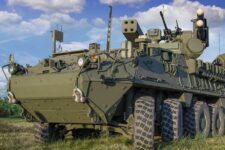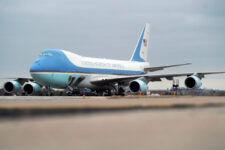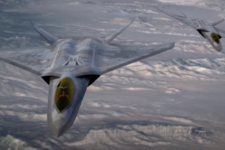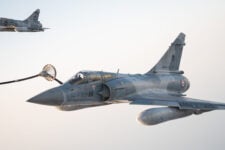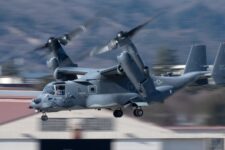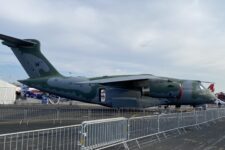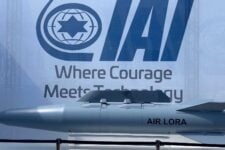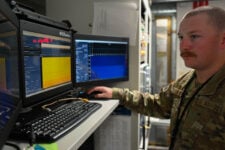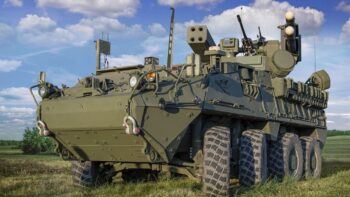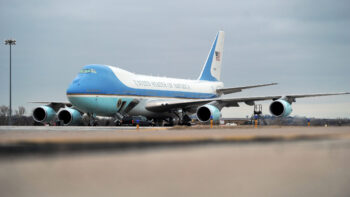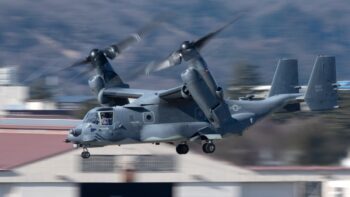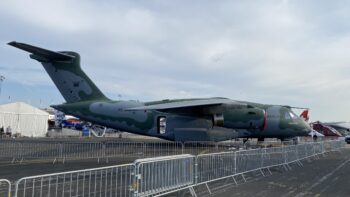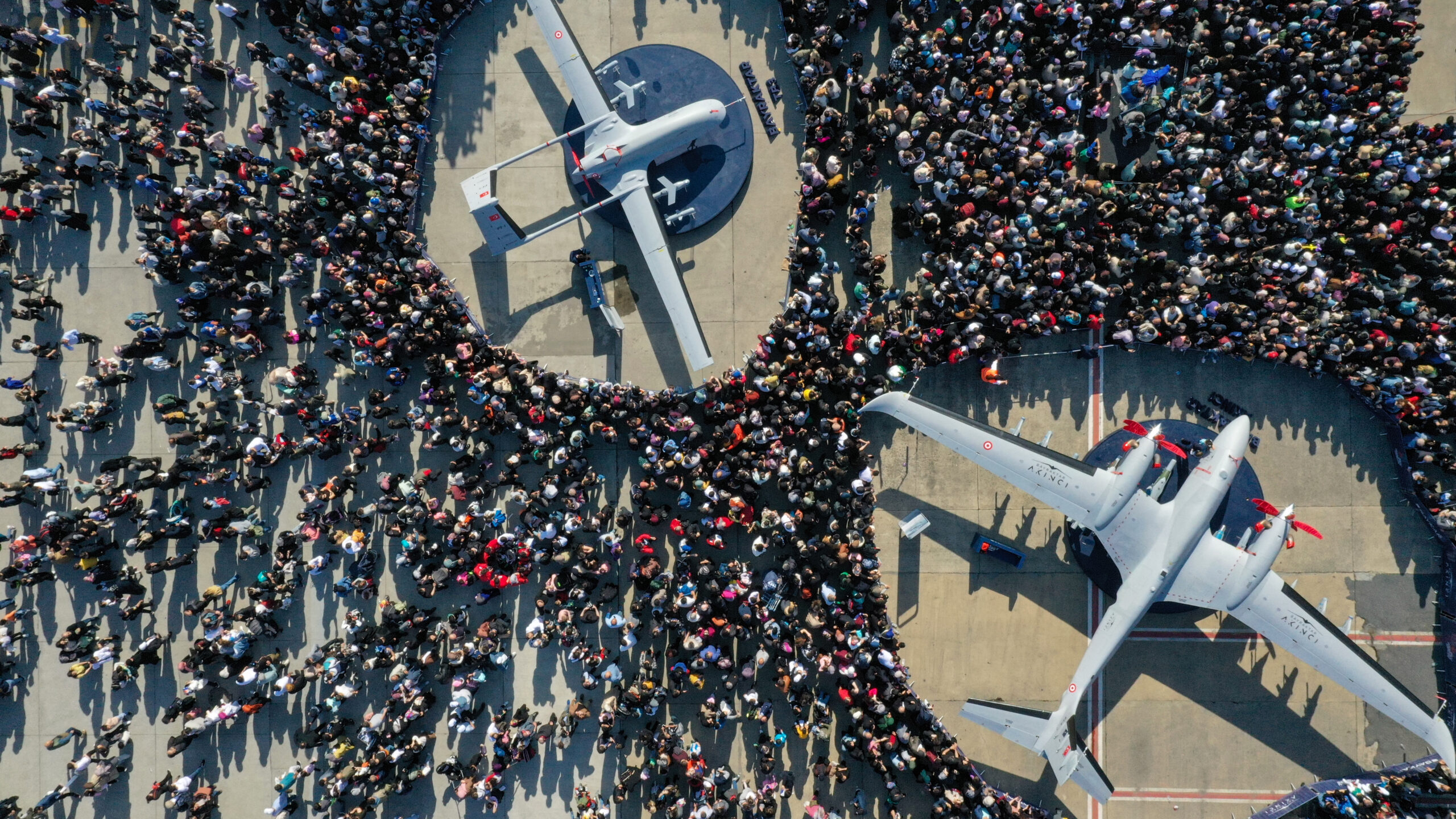
An aerial view of Bayraktar TB2 (L) and Akinci (R) as people visit the planes during the fifth day of the Turkiyeâs largest technology and aviation event TEKNOFEST at Istanbulâs Ataturk Airport in Istanbul, Turkiye on May 01, 2023. (Photo by Ali Atmaca/Anadolu Agency via Getty Images)
BEIRUT — Hours after the helicopter carrying Iranian President Ebrahim Raisi and Foreign Minister Hossein Amirabdollahian went down near the border of Azerbaijan Sunday, Iran reached out to its regional neighbor Turkey for assistance in finding the crash site through dense fog.
Turkey dispatched one of its thermal- and night-vision capable, domestically produced AKINCI unmanned aerial vehicles, and, according to Turkish officials, they discovered the downed chopper. Turkish media released video of what was supposedly the “heat source” identifying the crash.
Then on Wednesday the story took an unusual turn when Iran’s military put out a statement claiming that Turkey’s drone did not, in fact, find the crash site. It didn’t say what did. The military also noted that Iran had not used its own high-tech drones because they were away on an “major mission” at the time.
Can Kasapoglu, a Turkish defense expert and senior fellow at the Hudson Institute, said he wasn’t buying Tehran’s claim, suggesting it was a face-saving maneuver.
“Iran was dwarfed by the Turkish information superiority [and] overshadowed by NATO standards,” he said.
But more broadly, Kasapoglu and other experts told Breaking Defense that while both Turkish and Iranian drones have been the subject of much discussion lately, the episode offered a window into what analyst Mohammed Soliman called “an interesting asymmetry” between their respective UAV capabilities.
“Iran’s reliance on Turkish assistance in such scenarios suggests potential shortcomings in its own night vision and thermal imaging capabilities,” said Soliman, director of Strategic Technologies and Cyber Security Program at the Middle East Institute. “Effective ISR also hinges on real-time data processing and analysis. If Iranian drones lack these functionalities, their usefulness in both military and Search and Rescue (SAR) operations would be significantly hampered.”
Ali Bakir, a non-resident senior fellow at the Atlantic Council’s Scowcroft Middle East Security Initiative, agreed.
“Not to underestimate the challenging environment of the crash site, but the fact that the Iranians lost approximately 12 hours using primitive and limited-capability methods in the SAR [synthetic aperture radar] operations is quite telling,” he told Breaking Defense.
Bakir said that while some Iranian drones may function similarly to foreign drone systems since “many of them incorporate Western-sourced components, … they are not sophisticated, technologically advanced, or equipped with the right systems [compared to] their Turkish counterparts.
“The Iranian drones are primarily kamikaze-style, intended to be annoying and disruptive, yet technologically rudimentary,” he said.
Iranian, Turkish Drones Make Their Names In Different Wars
That kamikaze-style attack has put Iranian drones in the spotlight since Russia’s invasion of Ukraine, as the US and Ukraine say Russian forces have used them by the dozens there. More recently Iranian UAVs were part of Tehran’s largely unsuccessful missile and drone attack against Israel in mid-April.
In both cases, the aggressors are believed to rely on one-way attack drones, though Iran has developed larger combat platforms purportedly capable of surveillance as well, some allegedly with accidental US help. Those are, presumably, the drones that were off on the “major mission” when Raisi’s helicopter went down.
The crises in Ukraine and the Middle East have piqued some international interest in Iranian wares, analysts have said, even taking into account their relatively poor performance against Israel, especially from militaries who don’t plan to face off against cutting edge Western air defenses.
Iran has gone so far as to market its drones among other arms at the DIMDEX 2024 defense show in the Gulf, where officials told Breaking Defense that Iran would would sell their systems to any country except US and Israel.
Turkey, on the other hand, saw interest in its UAVs skyrocket after they were used on the other side of the Russian conflict early in the fight, especially the Medium-Altitude Long-Endurance (MALE) TB-2 Bayraktar, which offered a potent counter to invading forces.
RELATED: With Turkish drones in the headlines, what happened to Ukraine’s Bayraktar TB-2s?
Ever since, international interest in Turkish systems has grown. Last July, Saudi Arabia and Turkey agreed to the largest defense sale in Ankara’s history for Turkey’s AKINCI UAV — the same model used to find Raisi’s helicopter — though neither side offered details about the deal at the time.
Analysts said Iran and Turkey’s diverging drone strategy and industry output are the result of the threats, and opportunities, they see.
Fabian Hinz, a research fellow for Defense and Military Analysis at the International Institute for Strategic Studies, said that to a large extent “Iranian drone development has been driven by the requirements of asymmetric warfare against the more conventionally more powerful opponent like Israel, this is why they’ve developed a lot of smaller drones, loitering munitions and one-way attack UAVs.”
On the other hand, Turkey’s development approach has been a little more conventional, exemplified by the larger MALE UAVs.
“For example, [there is] nothing in Iranian service that has the same capabilities [and] payload as the AKINCI, that is actually in service,” Hinz said. Iran has unveiled a heavey turboprop UAV — dubbed Gaza, before the outbreak of the new round of hostilities there — but it’s not currently in service, Hinz said.
MEI’s Soliman said, “For decades, sanctions have hampered Tehran’s access to essential Western IP [intellectual property]. Contrarily, Ankara, a NATO member, enjoyed full access to both Eastern and Western IP, which has been instrumental in building a formidable indigenous military industry and propelling Turkey to become a drone superpower.”
Soliman said that Iran’s drones are “often perceived as less sophisticated, particularly in terms of ISR and electronic warfare capabilities. This technological disparity is reflected in the export market, where Turkey has successfully established itself as a leader in drone technology, exporting its UAVs to several countries.”
Iran, meanwhile, “hasn’t achieved the same level of international recognition for its drone technology.”
Iran’s drones haven’t needed to be as sophisticated to make their mark internationally, however. “Iran, nonetheless, looms large, with low-cost, expendable solutions,” Kasapoglu said.
That may be a selling point for Iran’s drone industry, but it appears that when it comes to some national emergencies, the lack of a domestic capability can overshadow all else — no matter who actually found the chopper.
Meet Sergeant Stout: Army gives Stryker-Based M-SHORAD a proper name
As the service rolls out a name change for the new(ish) air defense weapon, it is also eyeing future upgrades that could integrate with robots and new interceptors.
